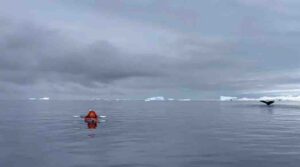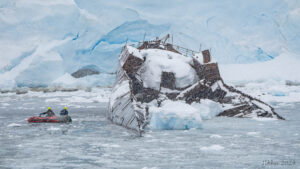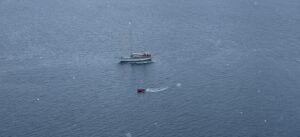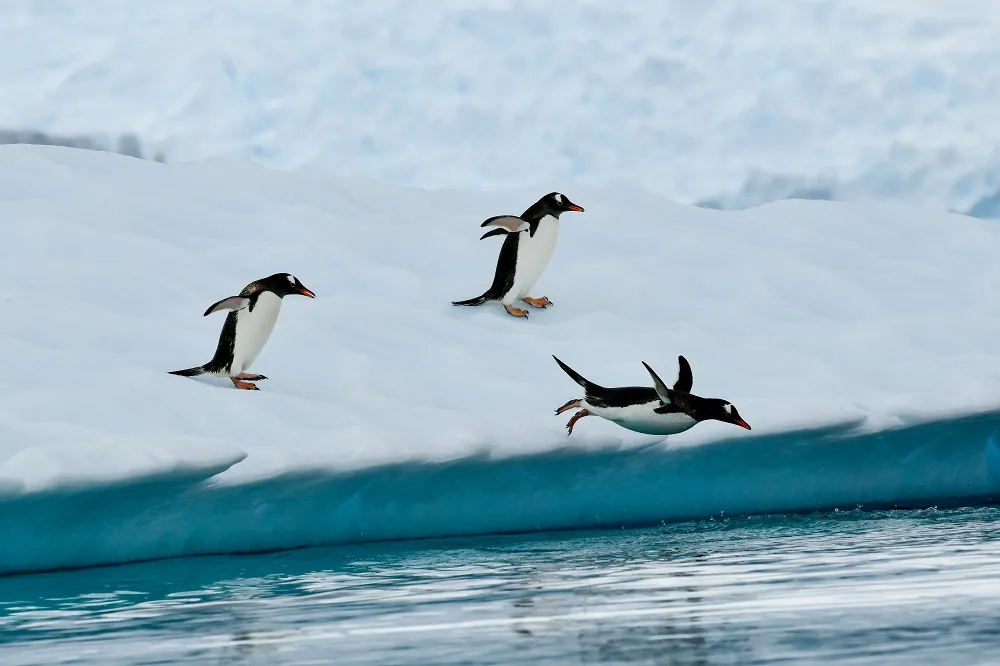18 February, 2023
We woke up for a second time in Foyn Harbour. Unlike the foggy dawn of our first full day on the Antarctic Peninsula, our final full day on the Peninsula started clear and we were blessed with a lurid sunrise. These colourful dawns are quite rare so we savoured the changing patterns of clouds over the snow-capped peaks for as long as the display remained. A truly special start to any day, and even more meaningful here in Antarctica.
Before breakfast the crew raise the anchor and we started motoring to nearby Charlotte Bay. We’d looked over the scenic bay on our continental landing at Portal Point a few days earlier but today we were excited to be taking a zodiac tour to check out icebergs, an enormous glacier and hopefully get a glimpse of whales from water level. While the crew did all the hard work we enjoyed yet another sumptuous breakfast and then got into our warm waterproofs.The routine is familiar now: multiple layers of insulated clothing with a waterproof outer shell top and bottom, don neck warmer and beanie (warm hat for those not from Australia), choose camera and lens (check battery and memory card), get into our thick neoprene and rubber muck boots and put on the life vest and, finally, pull on gloves. For Queenslanders, this is quite foreign attire indeed!
The whales seemed quite shy at first. We saw several plumes from their spouts and made our way in that direction, but they remained elusive for the time being. Luckily there was plenty else to see and we inspected icebergs of all forms and sizes, cruised to a respectful distance from the terminal face of an impressively huge glacier and watched Weddell Seals bask on the snow. As we moved away from the seals we spotted some more whale plumes. This time we were treated to a wonderful display by two adults and a juvenile Humpback Whale. They played around languidly for seemingly ages: floating up at the surface for long stretches, diving for short spells regularly and even waving fins. Every time the whale tail, or fluke, flashed at us the clatter of camera shutters was heard around the boat.
After a while, we realised the whales had started bubble feeding. We’d watched this behaviour in Wilhelmina Bay a few days earlier, but it was quite another thing to watch it from so close, and right from the waterline. With each pass, they came closer to the zodiac and we were treated to all the snorts and splashes of these enormous mammals in their natural environment. Within a few moments they were only 20 metres from our little boat and we all electrified by their proximity and enormous size. Far too close to photograph, we put down our cameras and drank in the occasion fully. A few moments more and the huge creatures dived right below us. Like being in the calm after the storm, we sat dazed and then murmured excitedly about what we’d just experienced. It was only then that we realised there was a ring of bubbles encircling our zodiac. As this was pointed out, I know there were a few terrified moments amongst us as the implications sunk in. We’d watched the behemoths surge from the depths enough times to easily envisage our tiny craft being sent flying in that eruption. Spending more than a moment in the Antarctic waters without a dry suit would have consequences not worth contemplating. But of course whales are highly intelligent creatures and they knew exactly where we were and left us in peace and in a sense of awe. We didn’t see them again.
Back on board the Hans Hansson, we had a hot lunch and Skyla gave us a talk about the Happy Whale program. Photographers can register at happywhale.com, submit photographs of their dorsal fins and flukes and, like fingerprints, these unique shapes can be matched by computer to ones in their ever-growing database. This allows individuals to be tracked around the globe for research purposes, and whales recorded for the first time get to be named by the photographer who submitted the shot. The same program is also used to track other whale species, Weddell Seals, Leopard Seals and even Blue Eyed Cormorants. We learned of a similar program last year that tracks Manta Rays.
After this, there was a transit to D’Hainaut Island where we had a landing. By this time the Antarctic had changed, as is all too frequent down here, and it was now cold, gloomy and raining. This was the perfect backdrop for the sombre reminder of the region’s past. A former whaling station, there were piles of whale bones on the beach and remnants of discarded water boats. These were apparently filled with ice and provided fresh water to the large ships and their enormous boilers used to process the whale blubber. There were also Gentoo Penguins by the thousand, scores of Skuas and even a Fur Seal. Being late in the day, we were enchanted by the return of countless penguins who’d spent the day up to 15km away, diving to depths of up to 200 metres in search of small fish and krill. These comical-looking creatures on land with their short legs are like torpedos in the water. When they return from their daily forage, they can be seen porpoising from 100 metres out singly or in small groups. Within just a moment they can be seen as dark shapes below the surface and then suddenly they’re right at the water’s edge. Their speed is astounding and their poise underwater is breathtaking. Finally we had to return to the warm, dry ship waiting patiently for us. But first we had to get through the block ice that had surrounded the zodiac. It was too dense to start the motor for a while so we needed to resort to gondola poling and paddling with oars. A moment’s hard work before the trusty motor kicked in. Hats off to the sailors of the past who crewed the water boats left on the beach and had to use their strength to manoeuvre them in these and worse conditions.
Another very memorable day in the deep south.
Words and photos by Andrew Teakle










